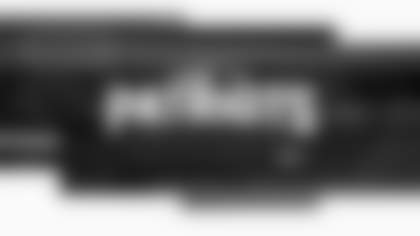The Patriots winning streak is tied for the league-high at five games, and the verbal bouquets are out in droves for New England around the NFL.
Although it's all deserved, the conversation around the Patriots is shifting. We know they are a good football team at 6-2, but now it's about hitting their ceiling to become a great team and a true title contender. As much as we enjoy highlighting the positives, there are a few trends that, as the stakes increase, are areas the Patriots might work to improve moving forward.
Offensively, a few stats that stand out are the passing offense against man coverage and Patriots QB Drake Maye's growing number of sacks. Maye is the second-most efficient passer in the NFL against zone coverage in EPA per drop-back (+0.29). However, Maye's efficiency dips slightly to 13th when he faces man coverage (+0.17). As for the sacks, Maye has now taken the second-most sacks (28) and has the second-highest pressure-to-sack rate (26.9%) among qualified quarterbacks.
The Patriots passing offense is still a net-positive against man coverage, and Maye's mobility is a huge a factor, like it was on his 28-yard scramble vs. the Browns, which is probably why opponents only play man coverage on 26.8% of Maye's drop-backs. Plus, OC Josh McDaniels will have man-beaters at the ready like rub routes and will matchup hunt with his backs and tight ends. Maye's play extension skills also make it tough to stick with receivers on extended drop-backs (example: WR DeMario Douglas's 44-yard catch last week).
Still, the Browns had some success playing man coverage. Maye was sacked five times, including a strip-sack, and intercepted against man coverage. The Pats have experienced receivers in Stefon Diggs, Mack Hollins, and their veteran tight end duo, who have great instincts against zone structures. But defeating man coverage is more about receivers creating separation and timing with the quarterback than scheme. Eventually, it'll be interesting to see if defenses challenge the Pats receivers to consistently get open against press coverage.
As for the defense, the Patriots are fourth in scoring defense (18.3 PPG) but are just 28th in pass defense DVOA, which adjusts for the strength of their opponents. The Pats are one of two defenses that rank outside the top-15 in pass DVOA but are a top-10 scoring defense (49ers are the other). Along those same lines, New England ranks last in EPA per play on the opponents' first two drives but improves to second the rest of the game. The question is, is that sustainable against better offenses down the road?
Again, pointing out these trends isn't to rain on Patriots fans' parade. New England is trending toward being a playoff team, but with that comes higher standards, which is what every team wants. Due to their strong performance, we're recalibrating our expectations for the 2025 Patriots.
On Sunday, the Patriots will try to make it six straight wins against the Atlanta Falcons at Gillette Stadium. The Falcons are one of those teams whose record (3-4) doesn't necessarily reflect their roster talent. Atlanta has plenty of star power with RB Bijan Robinson, WR Drake London, TE Kyle Pitts, Pro Bowl RG Chris Lindstrom, and CB A.J. Terrell — talent is not the issue in Atlanta.
Part of the Falcons inconsistencies are injury-related, with starting QB Michael Penix Jr. (knee) and London (hip) missing the Falcons loss to the Dolphins. Obviously, we'll all be monitoring Atlanta's injury report this week. Still, the Falcons are wildly inconsistent. On the one hand, they upset the Bills in a 24-14 win in Week 6, but they've also lost blowouts to Carolina (30-0) and Miami (34-10), two of the worst teams in the NFL.
The Patriots can't take the Falcons lightly due to their roster talent. It's a dangerous group of skill players along with the 10th-ranked defense in DVOA that is great at limiting explosive pass plays. That said, which Falcons team, and which Falcons quarterback, the Patriots get might decide how competitive this game is on Sunday.
Let's break down the schematic chess match between the Patriots and Falcons in Week 9.
Patriots Offense Key: Utilizing Gap Runs to Find Explosive Plays in a Strength-on-Strength Matchup
After studying the Falcons this week, their scheme on defense caught the eye more than their offense, which is why the defense is playing above its talent level.
| Stat, 2025 Season | Patriots Offense | Falcons Defense |
|---|---|---|
| Pass YPG | 240.5 (9th) | 149.1 (1st) |
| EPA/Pass | +0.33 (2nd) | +0.03 (12th) |
| Pass DVOA | 44.7% (3rd) | -5.7% (8th) |
| Explosives % | 12.7% (2nd) | 6.0% (2nd) |
Statistically, the Patriots pass offense against the Falcons pass defense is a strength-on-strength matchup. Atlanta leads the NFL in pass defense (149.1 YPG), while the Patriots rank ninth in passing yards on offense (240.5 YPG). This is also one of the most explosive passing offenses (12.7% explosive play rate, 2nd in NFL) versus a defense built to prevent explosive pass plays (6.0%, 2nd in NFL).
On paper, Atlanta's defensive talent doesn't jump out at you. Terrell is a good cover corner, they've got some solid vets up front (OLB Leonard Floyd and DT David Onyemaya), a good blitzing inside linebacker in Kaden Elliss, and a solid safety tandem with Jessie Bates and rookie Xavier Watts. Plus, first-rounder Jalen Walker (groin) has a bright future, but he is among the many Falcons who are banged up. Although the Falcons have some intriguing players on defense, this isn't the Browns defense in terms of personnel. But they're 13th in scoring defense thanks largely to a dynamic scheme.
Atlanta head coach Raheem Morris and DC Jeff Ulbrich are getting the most out of their players by running their version of the "Seattle-3" defense. The Falcons base their defense out of an odd front (3-4) while playing a league-high rate of single-high safety coverages (71.7%) and the second-highest rate of cover-three zone (45.3%). Like most Seattle-3 disciples, like Ulbrich's former boss Robert Saleh, Atlanta utilizes more quarters structures to mix up the coverage shell, calling quarters at the seventh-highest rate in the NFL. You get about 65% of what the Falcons do defensively between those two coverages (most used coverages: cover-three, cover-one, quarters). But it gets trickier when Atlanta gets into obvious passing situations.
In obvious passing situations, the Falcons are deploying a Brian Flores-like pressure package, showing cover zero and falling into five and six-man zone structures. Atlanta disguises coverage at the third-highest rate and runs zone blitzes or fire zones, trailing only Flores's Vikings defense in zone pressure rate this season (28%). The combination of early-down zone coverages to limit explosive plays and disguised third-down pressures is mostly working for Atlanta.
The Falcons exotic pressures are pumping up their pass rush to ninth in pressure rate and eighth in pass-rush win rate, two metrics that are better than their talent on paper suggests. Given they're scheming at a high level defensively, the Patriots will need to attack some vulnerabilities in their early-down defense to stay on schedule vs. the Falcons on Sunday.
In the run game, the Falcons have struggled against gap schemes. In particular, Atlanta is giving up a league-high 6.9 yards per rush to power schemes and 5.1 yards per rush against counter runs (21st in the NFL), so run schemes with pulling linemen are causing problems for the Falcons.
For example, the 49ers crease the Falcons defense with C-Gap power-lead above. Along with the backside pulling guard, San Francisco uses the fullback to kick out the playside edge defender, which allows the tight end to climb to the second level along with the wrapping guard, getting RB Christian McCaffrey into the secondary for an explosive run.
Once they got the inside run actions rolling, the 49ers hit the Falcons with crack tosses to get the ball outside. By cracking the end with a wide receiver, the 49ers get LT Trent Williams to the second level and have FB Kyle Juszczyk lead the way. Essentially, the same runs the Patriots were using to get rookie RB TreVeyon Henderson loose last week.
As good as the Falcons pass defense has been, Atlanta is 24th in rush EPA and 29th in rush success rate, meaning there's a weakness to exploit in the Falcons run defense. Once they have the run-actions established, there are some ways to unlock the deep ball for QB Drake Maye against the Falcons base coverages.
For example, the Bills hit a big play off a post-cross play-action where they get early-down quarters. In these quarters schemes, the field safety often plays a "poach" technique, where their eyes are inside to take any crossing routes, leaving the corner 1-on-1 with the outside receiver. In this clip, speedy WR Josh Palmer runs the post while the tight end's crossing route draws both safeties in coverage, and Palmer gets favorable leverage versus CB Mike Hughes without inside help for a huge gain – a very similar play to WR Kayshon Boutte's 39-yard TD vs. the Browns.
Last week, the Falcons defense had its worst performance of the year against Dolphins QB Tua Tagovailoa, who added +0.39 expected points per drop-back. Most of Tua's big plays also came off run-actions, with Tagovailoa hitting WR Jaylen Waddle for an explosive score off a toss-action that opened up Atlanta's cover-three zone on the same post-cross concept.
The Falcons defensive scheme is legit, but between the gap runs and early-down shot plays off play-action, there's a formula for the Patriots to play their brand of offense on Sunday.
Patriots Defense Key: Increase the Man Coverage Usage vs. the Falcons Offense
Moving over to the other side of the ball, Atlanta does some creative scheming on offense, but how productive are all the bells and whistles?
The Falcons do some neat things formation-wise and with motion. As a McVay disciple, OC Zac Robinson leads the league in motion at the snap rate (60.6%). They're big on moving Robinson around, in particular, starting him flexed out and then motioning him into the backfield, or vice versa. Atlanta also uses jet motion as window dressing to set up their outside zone and boot schemes, while creating funky formations to create four-strong (four-receiver sides) spacing, which is unique.
For example, the Falcons put Robinson in "orbit" motion around the quarterback to create a four-strong screen side and a backside slant into the wide side of the field. Penix likely makes a pre-snap read based on the defensive structure, throwing the slant into space with the defense putting four defenders over the four receivers to the screen side.
Despite running some creative schemes with good skill talent, the Falcons are 28th in scoring offense (17.1 PPG) and 23rd in DVOA. Some of that is due to inconsistent quarterback play. Before missing this last game, Penix had struggled in his second season, ranking 22nd out of 33 qualified quarterbacks in total QBR. He has great arm strength to push the ball outside the numbers and vertically from the pocket, but Penix struggles with his accuracy (31st in CPOE), doesn't see the middle of the field well, and isn't mobile.
Some predictability in Atlanta's offense scheme is also an issue. The Falcons rarely go under center, running their offense almost exclusively from the pistol or shotgun. The pistol, which the Falcons utilize at a league-high rate (46.7%), has similar mechanics to under-center because the back is behind the quarterback, so the run can still go in either direction. But the play-action fakes aren't quite as effective from the pistol; the Falcons are running the football 71% of the time out of their pistol formations, which is a tell. The Falcons also major in two-tight end sets, playing 12-personnel at the second-highest rate of any offense (43.7%).
When you play the Falcons offense, you can expect to see outside zone runs out of the pistol early and often. Atlanta is running outside zone at a league-high clip of 45.4% with duo or inside zone as their primary change-ups. It's not a diverse run scheme, so even with an uber-talented runner like Robinson, the Falcons are just 20th in rush EPA. Last week, Miami ignored their motions and consistently shut down outside zone.
The Falcons are also struggling against man coverage, whether it's Cousins or Penix. An interesting trend for the Patriots defense has been a lower rate of man coverage than some expected coming into the season. New England is 11th in man coverage rate (28.6%), ranking 31st in EPA per man coverage drop-back (+0.34). Still, if there's a game to bring out the cat coverage, it might be this one.
Regardless of the quarterback, the Falcons are last in EPA per drop-back vs. man schemes (-0.48). Those struggles might stem from having stationary pocket passers who can't stress man coverages with their legs. Plus, the Falcons don't create enough scheme-related conflict with rub routes and in-breakers that stress man coverage. Penix, in particular, won't throw to the middle of the field often, attempting just 20.5% of his passes to in-breaking routes (lowest rate among qualified quarterbacks).
The Falcons skill talent is legit, especially London and Robinson, two stars at their positions. The Pats stingy run defense vs. Robinson is a heavyweight bout, with the Falcons RB1 ranking fourth in yards after contact (429) with a league-high 36 forced miss tackles. Plus, the Pats have had issues covering tight ends (Pitts), and WR Darnell Mooney is a speed-slot who should be their best man-beating receiver.
That said, the fancy schemes are more for show than anything, which is why the Falcons are averaging more yards per play without motion (6.0) than with motion (5.4). If the Patriots defense keeps its wits about it through all the window dressing, Atlanta's offense becomes predictable.
Key Matchups
Pats SAF/LBs vs. Falcons TE Kyle Pitts/RB Bijan Robinson
If the Patriots play more man coverage this week, covering the Falcons dynamic tight end and running back will be the toughest assignments for New England. They have corners to guard London (if healthy) and Mooney (paging Marcus Jones). But the Pats are allowing the fifth-most receiving yards per game to TEs (67.9) and RBs (46.2), and will now face two great ones. It'll be interesting to see how they handle it schematically. Could this be the week CB Carlton Davis III covers the tight end (Pitts) in man coverage?
EDGE Harold Landry vs. Falcons RT Elijah Wilkinson
After suffering an ankle injury in Week 6, Landry has been a bit quiet, logging seven total pressures with one sack in his last two games (four sacks, 22 pressures in the first five games). This would be a good time to get going again against the Falcons backup right tackle, who ranks 58th out of 77 qualified tackles in PFF pass-blocking grade. Inside moves, which are Landry's specialty, gave Wilkinson some problems on film.
WR Kayshon Boutte vs. Falcons CB Mike Hughes
The Falcons play sides with their corners primarily sticking to the boundary (Terrell) and field (Hughes). My guess is the Pats will try to take a shot or two to Boutte with him matched up on Hughes, who has given up three deep TDs this season, tied for the most in the NFL.
DISCLAIMER: The views and thoughts expressed in this article are those of the writer and don't necessarily reflect those of the organization. Read Full Disclaimer











































